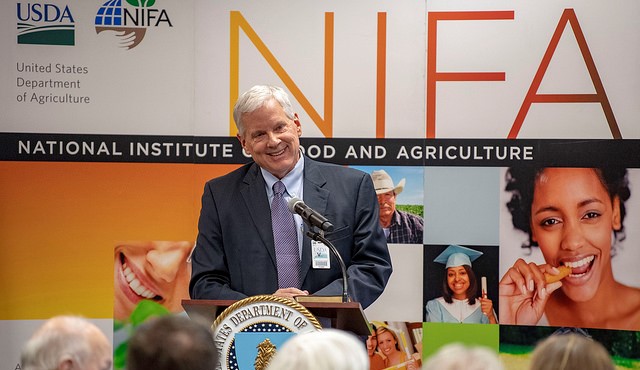NIFA investments provide transformative solutions
WASHINGTON — The U.S. Department of Agriculture’s (USDA) National Institute of Food and Agriculture (NIFA) in 2018 made investments in research, education and extension projects that will result in transformative discoveries to address significant agricultural and rural challenges in the United States.
“NIFA’s extramural research, education and extension funding and collaborations with leading scientists and extension professionals have delivered innovative solutions to address the most pressing agricultural and rural challenges,” said NIFA Director Dr. J. Scott Angle.
“NIFA’s continued strong collaboration with its grantees and partners helps American agriculture become more efficient and competitive, sustains natural resources and the environment, enhances the safety of our nation’s food supply and improves nutrition,” added Angle. As 2018 comes to an end, Angle highlighted several NIFA-funded projects in a number of areas that are representative of the crucial work that grantees have accomplished:
Maximizing Agricultural Productivity
Researchers at Clemson University developed the Agustina soybean cultivar, which possesses the long juvenile (LJ) trait, giving it the ability to produce high yields even when days get shorter. The LJ trait also allows the Agustina soybean to grow in regions that are not suited for most existing soybean cultivars. Agustina also is resistant to soybean cyst nematodes, the primary pest of soybeans.
A Texas A&M AgriLife scientist demonstrated that a commercially available sorghum variety provides protection against sugarcane aphids. Biological control of aphids was significantly improved on the resistant sorghum.
The Florida Department of Agriculture and Consumer Services used an Integrated Pest Management (IPM) Enhancement grant from the Southern IPM Center to deal with the conehead termite, an invasive termite in Southeastern Florida. If this invasive species disperses much further in Florida, agricultural operations including fruit groves, tree farms, plant nurseries and sugar cane fields will be at risk.
Cornell University researchers developed an integrated pest management (IPM) program for thrips, a small black fly pest species. Growers who used the program saved an average of $265 to $300 per acre. In the Columbia Basin of Washington and Oregon, adopting IPM practices to control thrips could increase onion crop value by more than $13 million per year.
University of California, Riverside developed a quarantine treatment program and measured it to be 100 percent effective in preventing the commercial spread of the glassy-winged sharpshooter, an insect that feeds on, and causes disease to, a variety of commercially sold nursery plants.
Responsible Agricultural and Forest Stewardship
A collaborative effort among the University of Arkansas System Division of Agriculture’s Cooperative Extension Service, Natural Resource Conservation Service, and County Conservation Districts has increased educational efforts on Irrigation Water Management practices, resulting in a 63 percent savings in energy, 50 percent reduction in water use, and $46.66 savings per acre of rice.
Washington State University Extension helped 1,500 landowners implement forest health and wildfire hazard mitigation practices across 125,000 acres of their ownerships. This active management will save costs related to firefighting costs, watershed protection, infrastructure damages, and human health.
Providing Assistance to Rural America During Disasters and Crises
In April 2018, damage from wildfires in Oklahoma exceeded $26 million. Oklahoma State University Cooperative Extension provided agricultural related relief to affected areas and families, matching producer needs with incoming donations. Meanwhile, Oklahoma 4-H youth development members raised $55,000 for affected families and packed 1,225 sack lunches for hundreds of firefighters battling the blaze.
The North Central Regional Center for Rural Development and Purdue Extension hosts a quarterly webinar series, Combating Opioids, to make a difference in addressing opioid misuse and abuse, especially in rural communities. Through this education, there have been over 575 participants from across the nation on five webinars and more than 1,000 views to archived presentations and materials housed on the project’s website.
Cooperative Extension offices in Florida were active in the local response to Hurricane Michael. The offices coordinated agricultural support by working with industry groups to obtain feed and supplies for cattlemen across the Panhandle.
Providing a safe, nutritious, and secure food supply
Scientists at the University of Minnesota have discovered that a single swine vaccine can control both a problematic swine pathogen Lawsonia intracellularis (L. intracellularis) and a harmful human pathogen Salmonella. While vaccines that target Salmonella directly are available on the market, this approach offers certain advantages: microbiome manipulations with anti-Lawsonia vaccine can protect against a diversity of Salmonella strains and is a cost-effective practice that is already in place on many farms.
Fort Valley State University developed a new pulsed ultraviolet (UV) light system that can kill up to 99.9 percent of pathogenic and spoilage microorganisms, molds, parasites, and insects. It can also kill bacteria on surfaces of food packaging materials without affecting taste or altering any other properties.
Crops and agroenvironmental sciences researchers at the University of Puerto Rico at Mayaguez assessed food safety risks in Puerto Rico’s agricultural system, and communicated food safety risk and interventions to stakeholders through seminars and commodity meetings.
NIFA’s mission is to invest in and advance agricultural research, education, and extension to solve societal challenges. NIFA’s investments in transformative science directly support the long-term prosperity and global preeminence of U.S. agriculture. To learn more about NIFA’s impact on agricultural sciences, visit www.nifa.usda.gov/Impacts, sign up for email updates, or follow us on Twitter @USDA_NIFA, #NIFAImpacts.
–USDA NIFA

